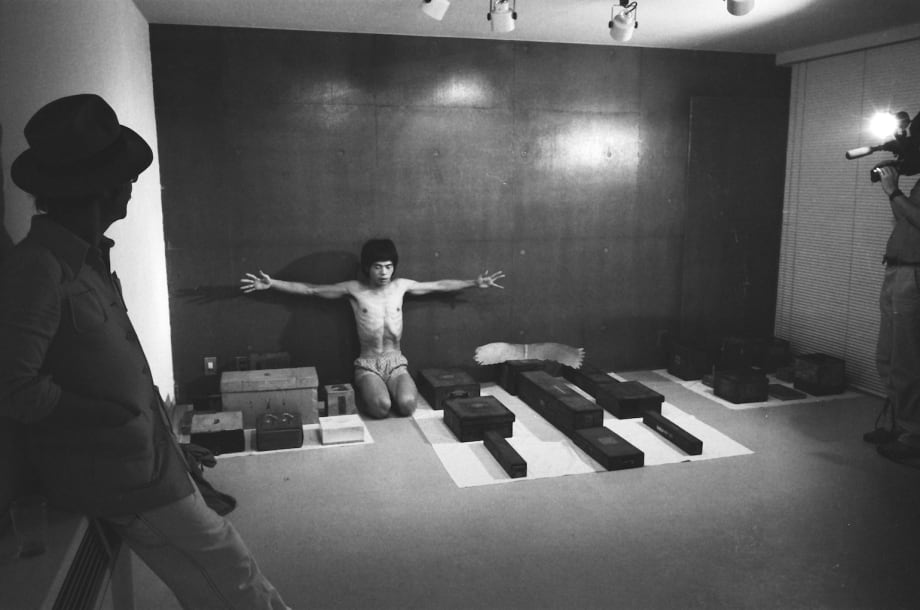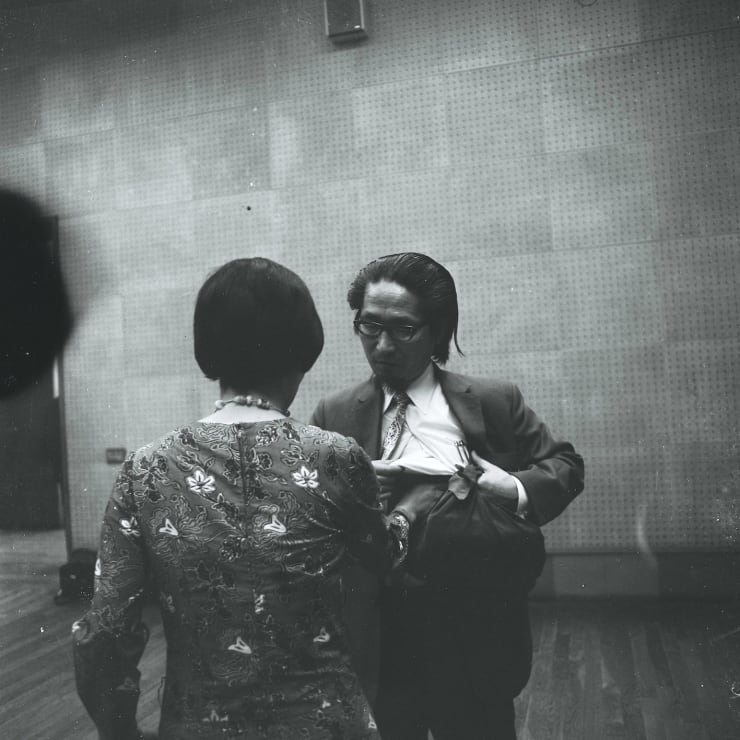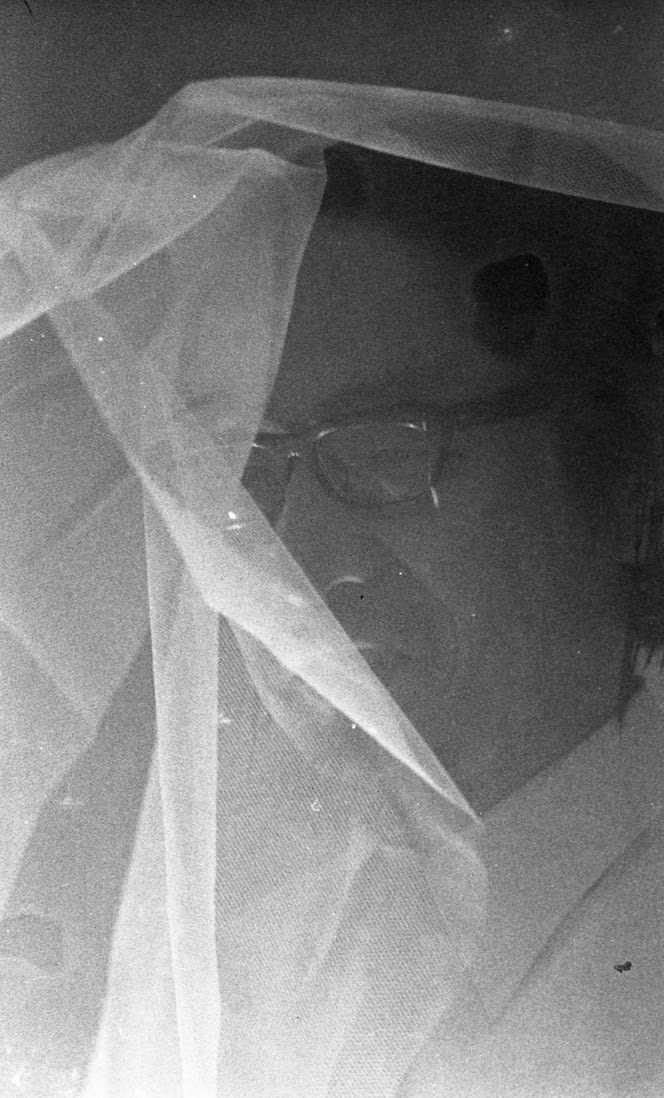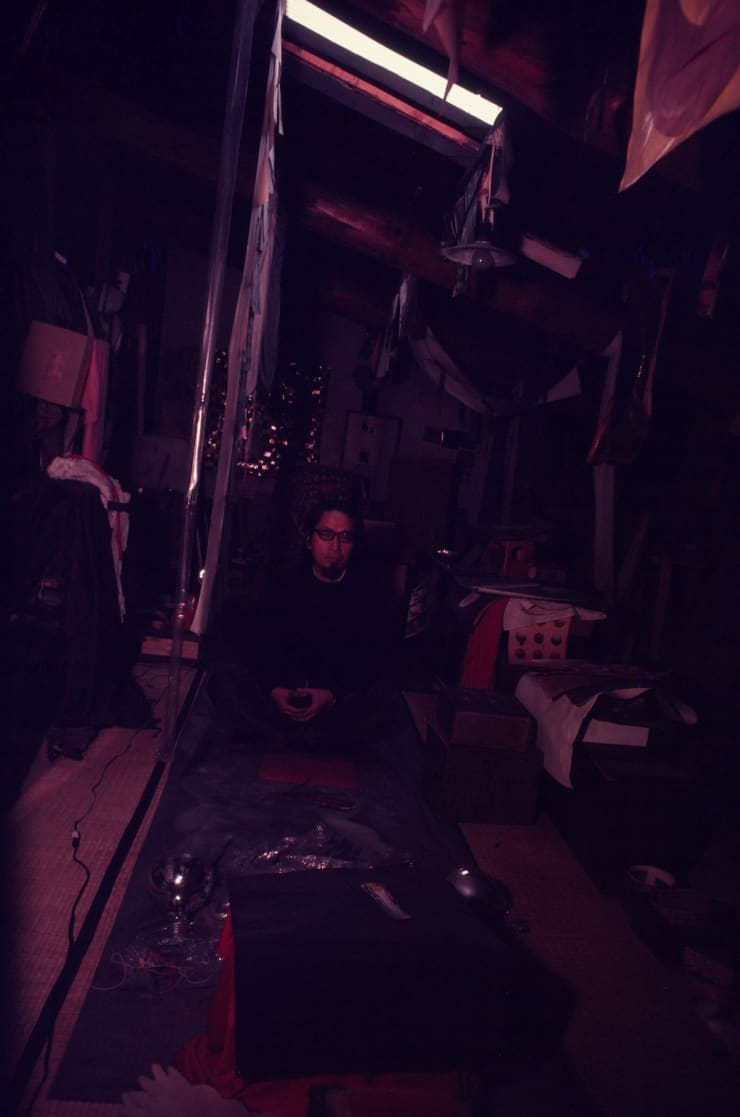Yutaka Matsuzawa through the lens of Mitsutoshi Hanaga
Yutaka Matsuzawa through the lens of Mitsutoshi Hanaga
Nonaka-Hill have organized Yutaka Matsuzawa through the lens of Mitsutoshi Hanaga, a small presentation of the photographer who documented the avant-garde in 1960s Japan, underground and youth culture, and such social issues as pollution and political activism.
The firsts for both of them on the West Coast, these exhibitions together illuminate the history of friendship and conceptual collaboration that they established while working on the fringes of the Tokyo-centered art world.
Yutaka Matsuzawa through the lens of Mitsutoshi Hanaga
Mitsutoshi Hanaga (1933-1999) was a prolific photographer documenting the thriving avant-garde art and youth-culture scenes of Tokyo and beyond. Concurrent with the exhibition Yutaka Matsuzawa, Nonaka-Hill is presenting a selection of thirteen works featuring the artist across decades of their friendship.
Like Matsuzawa, Hanaga was part of the “war-experienced generation.” Having lost his father at a young age, life’s hardships further compounded when he lost a lung due to tuberculosis in his early 20s and suffered a fall on a mountain, which compromised his mobility. Living with such life challenges, Hanaga naturally empathized with marginalized communities and turned his camera onto those who were often overlooked, valuing these figures as vital to cultural history, and worthy of being remembered throughout time. Hanaga passed away in 1999 and, recognizing the indispensible value of these photographs for the study of postwar culture and society, his son Taro established the Mitsutoshi Hanaga Archives Project to organize more than 100,000 negatives.
Drawn to the anti-establishment, Hanaga documented underground theaters, performance art, artists, protests, environmental pollution, and communes in Japan from the 1960s to the 1980s. When photographing artists, his interests were in the artists themselves, their concepts, and processes, more than their artworks, often capturing behind-the-scene moments.
One of Hanaga’s photographic subjects was Yutaka Matsuzawa, who entrusted Hanaga to witness and record a number of Matsuzawa’s private and public performances, encapsulating transient moments in time into his photographs. At Nonaka-Hill, Hanaga’s photographs of Matsuzawa include his Psi Room, the artist’s recently disassembled art installation in Shimo Suwa, Japan and select performances from 1969 onward. Hanaga's picture from 1969-70 portrays a younger Matsuzawa in a meditative pose inside the dense Psi Room, while his 1980s photo shows an older Matsuzawa standing with a silkscreen print with an egg image from Anata No Yomei (1986) in his home Japanese-style garden. A pair of photos, shot at Tokyo Biennale 1970: Between Man and Matter (an international exhibition that gathered works by artists known for conceptual, environmental, and performance art, such as Christo, Richard Serra, and On Kawara) show Matsuzawa's empty-room installation My Own Death, where he clandestinely performed with the Butoh dancer, Kazuko Tsujimura, who touched his chest to feel his future death. A color photograph depicts a Matsuzawa performance with Banner of Vanishing (1966) in Shimo Suwa in 1970, while a pair of black and white photographs, taken in the following year, show the artist spreading the banner dressed in a suit and tie in front of the Tokyo Metropolitan Art Museum for The 10th Contemporary Art Exhibition of Japan. Hanaga captured a sense of immediacy of these fleeting events, while evoking the enigma of Matsuzawa's presence.
Hanaga and Matsuzawa shared a distrust of built civilization, as shown in another solo exhibition “Curse Mantra: How to Kill Factory Owners / Jusatsu Kito Sodan (Mitsutoshi Hanaga),” currently on view at Para Site residency, Hong Kong. It features which his more socially minded series of radical anti-pollution Buddhist monks and is curated by Koichiro Osaka (Asakusa) and Aoyama | Meguro. Hanaga's earnest personal aspiration to connect with and to record Japan's culture, in the dynamic period in which he lived, will undoubtedly add immeasurable benefit to this study for many years to come.
Mitsutoshi Hanaga (b. Tokyo, 1933-1999)
His work has been exhibited at Pompidou Centre, Paris (1983), Asia Culture Center, Gwangju (2015), Tate Modern, London (2015), National Museum of Modern Art, Tokyo (2018), among many others.
Recommended viewing:
For a broader view of Mitsutoshi Hanaga’s work and Taro Hanaga’s efforts with the vast photographic archive, we recommend the watching “Following His Father’s Footsteps: Taro Hanaga with Reiko Tomii and Tom Looser”. This video documents an evening symposium at Asia Art Archive in America, Brooklyn, NY on March 11, 2019 (http://www.aaa-a.org/).
Books on / by Mitsutoshi Hanaga:
Hanaga Mitsutoshi. The Butoh. Tokyo: Gendai Shokan, 1983.
Hanaga Mitsutoshi, Hanaga Tarō, and Kuroda Raiji. Mitsutoshi Hanaga 1000. Tokyo:1000 Bunko, 2017.
 Mitsutoshi HanagaMatsuzawa Yutaka's Psi Zashiki Room in Shimo Suwa, Japan, 1969Gelatin silver print on fiber paper. (Hand printed by Seiji and Hatsumi Mizuno)Paper size: 14 x 11 in (35.7 x 27.8 cm)
Mitsutoshi HanagaMatsuzawa Yutaka's Psi Zashiki Room in Shimo Suwa, Japan, 1969Gelatin silver print on fiber paper. (Hand printed by Seiji and Hatsumi Mizuno)Paper size: 14 x 11 in (35.7 x 27.8 cm) Mitsutoshi HanagaMatsuzawa Yutaka's Psi Zashiki Room in Shimo Suwa, 1969Gelatin silver print on fiber paper. (Hand printed by Seiji and Hatsumi Mizuno)Paper size: 11 x 14 in (27.8 x 35.7 cm)
Mitsutoshi HanagaMatsuzawa Yutaka's Psi Zashiki Room in Shimo Suwa, 1969Gelatin silver print on fiber paper. (Hand printed by Seiji and Hatsumi Mizuno)Paper size: 11 x 14 in (27.8 x 35.7 cm) Mitsutoshi HanagaMatsuzawa Yutaka's Psi Zashiki Room in Shimo Suwa, Japan, 1969Gelatin silver print on fiber paper. (Hand printed by Seiji and Hatsumi Mizuno)Paper size: 14 x 11 in (35.7 x 27.8 cm)
Mitsutoshi HanagaMatsuzawa Yutaka's Psi Zashiki Room in Shimo Suwa, Japan, 1969Gelatin silver print on fiber paper. (Hand printed by Seiji and Hatsumi Mizuno)Paper size: 14 x 11 in (35.7 x 27.8 cm) Mitsutoshi HanagaMatsuzawa Yutaka Performing with “Banner of Vanishing” (Humans, Let's Go, Let's Go, Gate, Gate—Anti-Civilization Committee)" (1966) at The 10th Contemporary Art Exhibition of Japan at Tokyo Metropolitan Art Museum, May 1971, 1971Gelatin silver print on fiber paper. (Hand printed by Seiji and Hatsumi Mizuno)Paper size: 11 x 14 in (27.8 x 35.7 cm)
Mitsutoshi HanagaMatsuzawa Yutaka Performing with “Banner of Vanishing” (Humans, Let's Go, Let's Go, Gate, Gate—Anti-Civilization Committee)" (1966) at The 10th Contemporary Art Exhibition of Japan at Tokyo Metropolitan Art Museum, May 1971, 1971Gelatin silver print on fiber paper. (Hand printed by Seiji and Hatsumi Mizuno)Paper size: 11 x 14 in (27.8 x 35.7 cm) Mitsutoshi HanagaMatsuzawa Yutaka Performing with “Banner of Vanishing” (Humans, Let's Go, Let's Go, Gate, Gate—Anti-Civilization Committee)" (1966) at The 10th Contemporary Art Exhibition of Japan at Tokyo Metropolitan Art Museum, May 1971, 1971Gelatin silver print on fiber paper. (Hand printed by Seiji and Hatsumi Mizuno)Paper size: 14 x 11 in (35.7 x 27.8 cm)
Mitsutoshi HanagaMatsuzawa Yutaka Performing with “Banner of Vanishing” (Humans, Let's Go, Let's Go, Gate, Gate—Anti-Civilization Committee)" (1966) at The 10th Contemporary Art Exhibition of Japan at Tokyo Metropolitan Art Museum, May 1971, 1971Gelatin silver print on fiber paper. (Hand printed by Seiji and Hatsumi Mizuno)Paper size: 14 x 11 in (35.7 x 27.8 cm) Mitsutoshi HanagaMatsuzawa Yutaka's Sculpture with Performance, n.d.Gelatin silver print on fiber paper. (Hand printed by Seiji and Hatsumi Mizuno)Paper size: 11 x 14 in (27.8 x 35.7 cm)
Mitsutoshi HanagaMatsuzawa Yutaka's Sculpture with Performance, n.d.Gelatin silver print on fiber paper. (Hand printed by Seiji and Hatsumi Mizuno)Paper size: 11 x 14 in (27.8 x 35.7 cm) Mitsutoshi HanagaMatsuzawa Yutaka's "Around the Ψ Book on the Reconstruction of the World", n.d.Gelatin silver print on fiber paper. (Hand printed by Seiji and Hatsumi Mizuno)Paper size: 11 x 14 in (27.8 x 35.7 cm)
Mitsutoshi HanagaMatsuzawa Yutaka's "Around the Ψ Book on the Reconstruction of the World", n.d.Gelatin silver print on fiber paper. (Hand printed by Seiji and Hatsumi Mizuno)Paper size: 11 x 14 in (27.8 x 35.7 cm) Mitsutoshi HanagaMatsuzawa Yutaka Performing "My Own Death" with Tsujimura Kazuko, witnessed by Yamaguchi Katsuhiro, at "Tokyo Biennale 1970" at Tokyo Metropolitan Art Museum, May 10, 1970, 1970Gelatin silver print on fiber paper. (Hand printed by Seiji and Hatsumi Mizuno)Paper size: 14 x 11 in (35.7 x 27.8 cm)
Mitsutoshi HanagaMatsuzawa Yutaka Performing "My Own Death" with Tsujimura Kazuko, witnessed by Yamaguchi Katsuhiro, at "Tokyo Biennale 1970" at Tokyo Metropolitan Art Museum, May 10, 1970, 1970Gelatin silver print on fiber paper. (Hand printed by Seiji and Hatsumi Mizuno)Paper size: 14 x 11 in (35.7 x 27.8 cm) Mitsutoshi HanagaMatsuzawa Yutaka Performing "My Own Death" with Tsujimura Kazuko at "Tokyo Biennale 1970" at Tokyo Metropolitan Art Museum, May 10, 1970, 1970Gelatin silver print on fiber paper. (Hand printed by Seiji and Hatsumi Mizuno)Paper size: 14 x 11 in (35.7 x 27.8 cm)
Mitsutoshi HanagaMatsuzawa Yutaka Performing "My Own Death" with Tsujimura Kazuko at "Tokyo Biennale 1970" at Tokyo Metropolitan Art Museum, May 10, 1970, 1970Gelatin silver print on fiber paper. (Hand printed by Seiji and Hatsumi Mizuno)Paper size: 14 x 11 in (35.7 x 27.8 cm) Mitsutoshi HanagaMatsuzawa Yutaka Performing with “Banner of Vanishing” (Humans, Let's Go, Let's Go, Gate, Gate—Anti-Civilization Committee)" (1966) at Misayama Shrine, Shimo Suwa, Japan, 1970Inkjet color print on Epson paper.Paper size: 14 x 11 in (35.7 x 27.8 cm)
Mitsutoshi HanagaMatsuzawa Yutaka Performing with “Banner of Vanishing” (Humans, Let's Go, Let's Go, Gate, Gate—Anti-Civilization Committee)" (1966) at Misayama Shrine, Shimo Suwa, Japan, 1970Inkjet color print on Epson paper.Paper size: 14 x 11 in (35.7 x 27.8 cm) Mitsutoshi HanagaMatsuzawa Yutaka in Mieko Shiomi Performance, n.d.Gelatin silver print on fiber paper. (Hand printed by Seiji and Hatsumi Mizuno)Paper size: 14 x 11 in (35.7 x 27.8 cm)
Mitsutoshi HanagaMatsuzawa Yutaka in Mieko Shiomi Performance, n.d.Gelatin silver print on fiber paper. (Hand printed by Seiji and Hatsumi Mizuno)Paper size: 14 x 11 in (35.7 x 27.8 cm) Mitsutoshi HanagaMatsuzawa Yutaka at His Psi Zashiki Room in Shimo Suwa, Japan, n.d.Inkjet color print on Epson paper.Paper size: 14 x 11 in (35.7 x 27.8 cm)
Mitsutoshi HanagaMatsuzawa Yutaka at His Psi Zashiki Room in Shimo Suwa, Japan, n.d.Inkjet color print on Epson paper.Paper size: 14 x 11 in (35.7 x 27.8 cm) Mitsutoshi HanagaMatsuzawa Yutaka with “Pilofile: An Egg of Phalorus Phalorus” (1986), 1980sGelatin silver print on fiber paper. (Hand printed by Seiji and Hatsumi Mizuno)Paper size: 11 x 14 in (27.8 x 35.7 cm)
Mitsutoshi HanagaMatsuzawa Yutaka with “Pilofile: An Egg of Phalorus Phalorus” (1986), 1980sGelatin silver print on fiber paper. (Hand printed by Seiji and Hatsumi Mizuno)Paper size: 11 x 14 in (27.8 x 35.7 cm)
Related Artists
Artist Exhibited:
Ulala Imai
Kazuo Kadonaga
Kentaro Kawabata
Zenzaburo Kojima
Kisho Kurokawa
Tadaaki Kuwayama
Toshio Matsumoto
Keita Matsunaga
Yutaka Matsuzawa
Kimiyo Mishima
Kunié Sugiura
Takuro Tamayama
Tiger Tateishi
Sofu Teshigahara
Shomei Tomatsu
Wataru Tominaga
Hosai Matsubayashi XVI
Kansuke Yamamoto
Masaomi Yasunaga
Exhibitions:
-2025-
KEY HIRAGA: The Elegant Life of Mr. H
-2024-
KYOKO IDETSU: What can an ideology do for me?
KENTARO KAWABATA / BRUCE NAUMAN
SAORI (MADOKORO) AKUTAGAWA: CENTENARIA
Keita Matsunaga : Accumulation Flow
-2023-
NONAKA-HILL ♥ TATAMI ANTIQUES: A holiday sale of unique objects from Japan
TAKASHI HOMMA : REVOLUTION No.9 / Camera Obscura Studies
TATSUMI HIJIKATA THE LAST BUTOH: Photographs by Yasuo Kuroda
Kiyomizu Rokubey VIII: CERAMIC SIGHT
Masaomi Yasunaga: 石拾いからの発見 / discoveries from picking up stones
SHUZO AZUCHI GULLIVER ‘Synogenesis’
Koichi Enomoto: Against the day
Tatsuo Ikeda / Michael E. Smith
Hiroshi Sugito: the garden with Zenzaburo Kojima
Zenzaburo Kojima: This very green
Tomohisa Obana: To see the rainbow at night, I must make it myself
Daisuke Fukunaga: Beautiful Work
- 2021 -
Natsuyasumi: In the Beginning Was Love
Takashi Homma: mushrooms from the forest
– 2020 –
Hosai Matsubayashi XVI & Trevor Shimizu
Sterling Ruby and Masaomi Yasunaga
– 2019 –
A show about an architectural monograph
Yutaka Matsuzawa
Yutaka Matsuzawa through the lens of Mitsutoshi Hanaga
Takuro Tamayama & Tiger Tateishi
Kunié Sugiura
Masaomi Yasunaga
Miho Dohi
Wataru Tominaga
Naotaka Hiro
Parergon: Japanese Art of the 1980s and 1990s
Tadaaki Kuwayama
– 2018 –
Toshio Matsumoto
Kentaro Kawabata
Kansuke Yamamoto
Kazuo Kadonaga: Wood / Paper / Bamboo / Glass
Press:
-2025-
Artillery Magazine, Sawako Goda
-2024-
Artsy, Nonaka-Hill
Richesse, Nonaka-Hill Kyoto
Bijutsutecho, Nonaka-Hill Kyoto
The Art Newspaper, Nonaka-Hill Kyoto
Meer, Kyoko Idetsu
Bijyutsutecho, Masaomi Yasunaga
Switch, Masaomi Yasunaga
ARTnews JAPAN, Masaomi Yasunaga
Richesse, Masaomi Yasunaga
Art Basel, Daisuke Fukunaga, Imai Ulala
Art Basel, Kazuo Kadonaga, Sofu Teshigahara
-2023-
ADF webmagazine, Yasuo Kuroda, Tatsumi Hijikata
e-flux, Sanya Kantarofsky, Yasuo Kuroda
Los Angeles Times, Kenzi Shiokava
Artillery, Masaomi Yasunaga
Contemporary Art Daily Shuzo Azuchi Gulliver
- 2022 -
Contemporary Art Daily, Tomohisa Obana
ARTE FUSE, Daisuke Fukunaga
Contemporary Art Daily, Daisuke Fukunaga
Contemporary Art Review Los Angeles (Carla), Daisuke Fukunaga
What's on Los Angeles, Daisuke Fukunaga
Hyperallergic, Daisuke Fukunaga
Artillery, Kentaro Kawabata
Larchmont Buzz, entaro Kawabata
- 2021 -
Art Viewer, Natsuyasumi: In the Beginning Was Love
Hyperallergic, Natsuyasumi: In the Beginning Was Love
Art Viewer, Takashi Homma
Hyperallergic, Busy Work at Home
Art Viewer, Busy Work at Home
Hyperallergic, Ulala Imai
Contemporary Art Review Los Angeles (Carla), Ulala Imai
Contemporary Art Daily, Ulala Imai
artillery, Ulala Imai
Special Ops, Ulala Imai
Art Viewer, Ulala Imai
artillery, Matsubayashi & Trevor Shimizu
– 2020 –
Ceramic Now, Sterling Ryby and Masaomi Yasunaga
Hypebeast, Sterling Ryby and Masaomi Yasunaga
Art Viewer, Sterling Ruby and Masaomi Yasunaga
Air Mail, Sterling Ruby and Masaomi Yasunaga
Los Angeles Times, Kaz Oshiro
ArtnowLA, Kaz Oshiro
What's on Los Angeles, Kaz Oshiro
KCRW, Kaz Oshiro
Tique, Kaz Oshiro
Contemporary Art Daily, Kaz Oshiro
Art Viewer, Kaz Oshiro
Contemporary Art Daily, Sofu Teshigahara
Art Viewer, Sofu Teshigahara
KCRW, Sofu Tsshigahara
Hyperallergic, Nonaka-Hill
Los Angeles Times, Keita Matsunaga
– 2019 –
Los Angeles Times, Tatsumi Hijikata
Art Viewer, Tatsumi Hijikata, Eikoh Hosoe
Contemporary Art Review Los Angeles, Tatsumi Hijikata, Eikoh Hosoe
ArtAsiaPacific, Yutaka Matsuzawa
Los Angeles Times, Tatsumi Hijikata
AUTRE, Tatsumi Hijikata, Eikoh Hosoe
Los Angeles Times, Nonaka-Hill
ARTFORUM, Takuro Tamayama, Tiger Tateishi
Art Viewer, Takuro Tamayama, Tiger Tateishi
KCRW, Nonaka-Hill
LA WEEKLY, Nonaka-Hill
AUTRE, Takuro Tamayama, Tiger Tateishi
ArtsuZe, Takuro Tamayama, Tiger Tateishi
ARTFORUM, Review: Tadaaki Kuwayama, Rakuko Naito
Art Viewer, Masaomi Yasunaga, Kunié Sugiura
Los Angeles Times, Masaomi Yasunaga
KQED, Tadaaki Kuwayama, Rakuko Naito
Contemporary Art Daily, Naotaka Hiro, Wataru Tominaga, Miho Dohi
Los Angeles Times, Miho Dohi
Los Angeles Review of Books, Miho Dohi
Bijutsu Techo, Naotaka Hiro, Wataru Tominaga, Miho Dohi
Art Viewer, Miho Dohi
Art & Object, Parergon
COOL HUNTING, Felix Art Fair
Art Viewer, Tadaaki Kuwayama
artnet news, Nonaka-Hill
Contemporary Art Review Los Angeles (Carla), Tadaaki Kuwayama
– 2018 –
Art Viewer, Kentaro Kawabata
Contemporary Art Daily, Kazuo kadonaga
Los Angeles Times, Kazuo Kadonaga
ARTFORUM, Kazuo Kadonaga
Contemporary Art Daily, Shomei Tomatsu
KCRW, Kimiyo Mishima, Shomei Tomatsu
This website uses cookies
This site uses cookies to help make it more useful to you. Find out more about cookies.
































